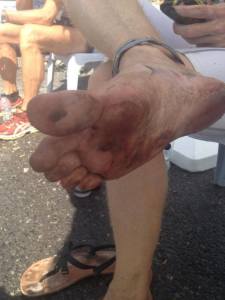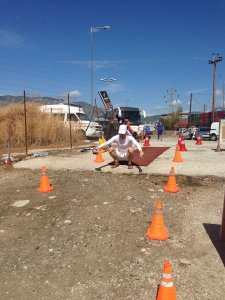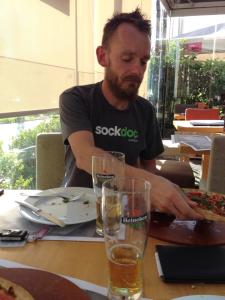 There are a lot of interesting stories from many great athletes out there, yet some of the best ones come from normal everyday people doing extraordinary things. There’s this crazy foot race in Greece called the Spartathlon held every September. Its 246 kilometers which works out to 153 miles for those of you not metric-savvy. Yes of course there has to be somewhat of a crazy person to do this race but the most craziest of all is someone who decides to run the entire race wearing sandals – just a mere 3-4mm of leather between the foot and the ground. Modern-day Viking Claus Rasmussen from Denmark is this nut who not only performed such an amazing feat, but became the first ever to do so in the 32 years the race has been held. I caught up with Claus some time after the race via Skype for the first-ever SockDoc interview. Not only is his account of the race interesting, but his outlook on training, minimalism, and running is of great value.
There are a lot of interesting stories from many great athletes out there, yet some of the best ones come from normal everyday people doing extraordinary things. There’s this crazy foot race in Greece called the Spartathlon held every September. Its 246 kilometers which works out to 153 miles for those of you not metric-savvy. Yes of course there has to be somewhat of a crazy person to do this race but the most craziest of all is someone who decides to run the entire race wearing sandals – just a mere 3-4mm of leather between the foot and the ground. Modern-day Viking Claus Rasmussen from Denmark is this nut who not only performed such an amazing feat, but became the first ever to do so in the 32 years the race has been held. I caught up with Claus some time after the race via Skype for the first-ever SockDoc interview. Not only is his account of the race interesting, but his outlook on training, minimalism, and running is of great value.
SD: Hey Claus, so was the race what you expected it to be?
CR: Yes and no. I expected it to be difficult but I didn’t expect the roads to be so terrible. Almost the entire race was run on tarmac. It was like running on a shitty-gravel mix-up highway for the majority of the race and it was up and down the whole time.
SD: Knowing that, would you have still run it in sandals?
CR: Yes. But if I return I might not wear sandals as there is so much downhill running there becomes a lot of friction between the first and second toe where the strap is. And of course sandals slow you down so if I were to return I’d want to run for time rather than just to finish.
 SD: What was the toughest part of the race?
SD: What was the toughest part of the race?
CR: There was a 4K stretch of really bad gravel – the loose stuff that gets under your feet but over the sandal. So I had to walk. And when you walk in sandals is when the gravel gets into the area between the foot and leather which becomes a problem. Also the mountain climb in the middle of the race was very though. It’s a 1,200 meter climb up Mount Parthenio in the dead of night. It’s covered with rocks and bushes and really harsh gavel on the back side of it so that made it a tough descent.
SD: But you kept the sandals on the whole way and not only that most runners change their shoes multiple times throughout the 36 hour race – correct?
CR: Correct. I never took the sandals off. There were some well-know runners who were running in Hokas at night only to put on more minimalist shoes during the day. Seemed like there were Hokas everywhere.
SD: Gotta look good during the day when people can see you and take photos.
CR: Of course. There are some people who won’t get hurt with or without Hokas and other maximalist shoes. Others only wear them to run though and it’s painful just looking at these people.
SD: Yes I agree and I can imagine that since those who need to wear them just to run are already broken they must be a disaster in such a race since they shouldn’t even been running in the first place. What a way to wreck your body.
 SD: So you must have stretched often during the race?
SD: So you must have stretched often during the race?
CR: (knowing I was joking) I did insane amounts of full squats at each aid-station throughout the race to stay loose, that’s it. (There were 74 aid stations in the race.)
SD: Impressive – that’s a great thing to do and one that most cannot do let alone during any race.
SD: How long did the race take you?
CR: I finished in 35 ½ hours which is just under the 36 hour cutoff. This is how I planned it as my goal was to finish and not destroy my body. I was tired, but not broken.
SD: You must have trained some serious mileage to prepare for this race?
CR: No, that is not my style or philosophy. I don’t believe in long runs – they just break you down. My longest training run was 23K and I did some stretches of these long runs once for six or seven days in a row and then another for three to four.
SD: I like that. Shorter distances back-to-back like that and being consistent in your training can really pay off without the harmful effects of training high mileage too often.
SD: How about your nutrition – what can you tell me there?
CR: I drank water diluted with Coke and some fruit/nut bars. I also consumed quite a few non-alcoholic beers.
SD: Elaborate on “quite a few”.
CR: Enough to fit in a Viking hand.
SD: Noted.
 SD: Did you have a support crew?
SD: Did you have a support crew?
CR: Yes, Number Two was there.
SD: Ah yes – good guy to have there. Michael who also joined you for my workshop in London. If I recall correctly half of his blood is pure caffeine.
CR: Would you believe that he doesn’t drink coffee anymore?
SD: No I don’t believe that. Is he still a Vegetarian?
CR: Yes.
SD: That’s too bad. I guess everyone needs to say they have one Vegetarian friend just so they can say they don’t discriminate. I like the photo of him wearing the Sock Doc London shirt at your post-race meal, or beer-fest.
SD: How did you feel after the race?
CR: Just overall muscle fatigue. I wasn’t broken and beat up like so many, just tired.
SD: Well done. I am more than impressed. Do you think that the fact that you’re a Viking gave you some advantage?
CR: Well all Vikings are insane. I am just a good representation of them.
SD: Well thanks for your time. Since that glass of wine you’ve been sipping on is just about gone we should end it here.
CR: Sounds good. (slurring words)
Running a race like this is quite a feat in its own right and running it in huarache sandals is even more amazing. However, in addition to that I really like Claus’ philosophy on training and running. He runs in minimalist “barefoot” footwear because he knows that it’s best for his body. If he’s feeling run-down or injured then he doesn’t just go and throw on some thicker supportive shoes to log in some miles. Rather, he listens to what is body his telling him and takes care of the issues so he can run again when he is ready – not because he’s got support (literally).
Also, his training style is smart. Yes, there are many, many different training philosophies and they need to be tailored to each individual. But many runners break down and become injured and sick because they log in huge mileage days over many weeks for too long of a cycle. Claus’ style of running “shorter” distances day after day until he felt like he wasn’t recovering is both smart and effective.
There’s a lot to learn from Claus and his race story. Check out Claus’ blog flatfoot.guru and his race review here: http://flatfoot.guru/spartathlon2014-race-report
Race link: http://www.spartathlon.gr/en.html
 Consult with
Consult with Sock Doc Workshops
Sock Doc Workshops
Adolfo Neto (@adolfont) says
Nice. I have run two marathons in Xero Shoes. But it was mainly because I couldn’t find a good minimalist running shoe in Brazil.
I don’t want to run a 50-mile ultra, much less a Spartathlon… 🙂 I used to say the same thing about Marathons, though… Congrats, Claus!
And, as I have told you, a Brazilian, Valmir Nunes, won this race a long time ago (2001):
http://en.wikipedia.org/wiki/Spartathlon
steven sashen says
You’d love talking to Melissa Gosse and Jon Sinclair (www.ultramelandjon.com) who ran the 250k+ 7-day Race the Planet stage race in Madagascar… in Xero Shoes.